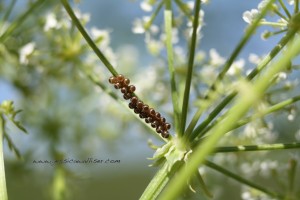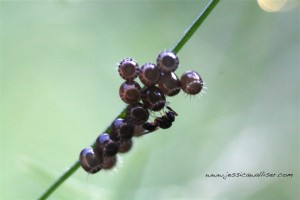 When someone hears the name stink bug, the likely reaction is a crunched up nose, a furrowed brow, and the utterance of the phrase “ewwww”. Having been subjected to the stench of these creatures on any number of occasions, I don’t blame them. With the majority of the 250 species of stink bugs in North America being plant-eating pests (and some of them serious ones at that), it’s easy to see why they have such a stinky reputation. The subfamily Asopinae, however, consists only of predatory species. These are the good guy stink bugs.
When someone hears the name stink bug, the likely reaction is a crunched up nose, a furrowed brow, and the utterance of the phrase “ewwww”. Having been subjected to the stench of these creatures on any number of occasions, I don’t blame them. With the majority of the 250 species of stink bugs in North America being plant-eating pests (and some of them serious ones at that), it’s easy to see why they have such a stinky reputation. The subfamily Asopinae, however, consists only of predatory species. These are the good guy stink bugs.
All stink bugs stink. Even the beneficial species emit a distinct odor when handled or threatened. It is a defense mechanism—and a good one at that. Predaceous members of the stink bug family are known to consume common garden pests like caterpillars, Japanese beetles, Mexican bean beetles, Colorado potato beetle, lygus bug nymphs, beetle larvae, bollworms, herbivorous stink bugs, and others.
Probably the most common and important predaceous stink bug is the spined soldier bug. The grayish brown adults have pointed shoulders with sharp points protruding from them. The rounded, wingless nymphs are orange with black markings. Spined soldier bugs, and other predaceous stink bugs, feed by stabbing prey with a knife-like mouthpart and consuming the innards. Spined soldier bugs are large, 0.35-0.55 in. (9-14 mm) long, and feed primarily at night. In addition, there are nine other predatory species sharing the Podisus genus with the spined soldier bug. There are also several other types of predatory stink bugs including the two-spotted stink bug, the anchor stink bug, and the handsome Tylospilus, along with their many relatives. While many predaceous stink bugs are generalist predators, several specialist species also exist.

The eggs of the spined soldier bug are downright beautiful (shown here and above). They have a shiny, metallic exterior and a brilliant blue interior—and the top of each egg is encircled with a single row of soft spikes. Be on the lookout for them in early summer. I often find egg clutches on flowering members of the carrot and daisy families.
The egg clutch in this picture, however, has fallen victim to intraguild predation (when one beneficial insect species preys upon another). A tiny parasitic wasp (less than 1/16 in. or 1.5 mm) in the family Platygastridae stands guard over the spined soldier bug eggs. She has inserted her own eggs into them and is now protecting them from other predators.







